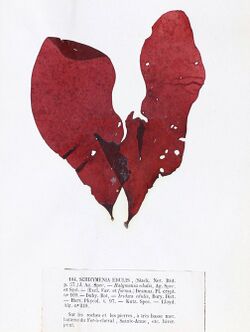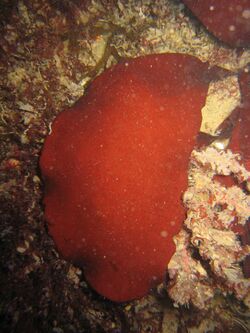Biology:Dilsea carnosa
| Dilsea carnosa | |
|---|---|

| |
| Scientific classification | |
| (unranked): | Archaeplastida |
| Division: | Rhodophyta |
| Class: | Florideophyceae |
| Order: | Gigartinales |
| Family: | Dumontiaceae |
| Genus: | Dilsea |
| Species: | D. carnosa
|
| Binomial name | |
| Dilsea carnosa (Schmidel) Kuntze (1898)
| |
| Synonyms | |
|
Fucus carnosus Schmidel (1794) | |
Dilsea carnosa, commonly known as the poor man's weather glass or the sea belt, is a species of red algae in the Dumontiaceae family of the order Gigartinales.
Taxonomy
The species was first described scientifically by Schmidel in 1794, under the name Fucus carnosus. The German botanist Otto Kuntze transferred the species to Dilsea in 1898.[1]
Description
This large alga is dark red, flattened and somewhat leathery. It may be 30 cm or more long and 15 cm wide. It is usually not branched but may split.[2] It grows from a small discoid base.[3] The mature blade has a compact medulla enclosed within a cortex of rounded cells inwards and outwards of close radial filaments of about 6 cells.[4] It grows from a discoid holdfast with a short stipe.[5]
Habitat
Attached to rock in the lower littoral,[6] to a depth of 24 m or more.[4] It grows from a discoid holdfast with a short stipe.[7]
Reproduction
The gametangial plants are dioecious, with male and female gametangia on separate plants. The spermatangia, male gametes, occur in patches near the edges of the fronds. Carposporangia release spores. Tetraspores occur near the margins and consist of four spores.[4]
Distribution
Generally distributed around the British Isles including the Shetland Isles and Isle of Man; from Portugal to Arctic Russia.[4][8]
References
- ↑ Kuntze, O. (1898). Revisio generum plantarum. Part 3 (3). pp. 1-576. Leipzig, London, Milano, New York, Paris: Arthur Felix, Dulau & Co., U. Hoepli, Gust. A. Schechert, Charles Klincksierck.
- ↑ Newton, L. 1931. A Handbook of the British Seaweeds. British Museum, London
- ↑ Bunker, F.StP. D., Brodie, J.A., Maggs, C.A. and Bunker, Anne R. 2017. Seaweeds of Britain and Ireland. Second Edition, Wild Nature Press, Plymouth, UK. ISBN: 978-0-9955673-3-7
- ↑ 4.0 4.1 4.2 4.3 Irvine, L.M.1983. Seaweeds of the British Isles. Volume 1, Rhodophyta Part 2A. British Museum (Natural History) ISBN:0 565 00871 4
- ↑ Dickinson, C.I. 1963. British Seaweeds The Kew Series
- ↑ Campbell, A.C. 1984. The Country Life Guide the Seashore and Shallow Seas of Britain and Europe. Country Life Books. ISBN:0 600 34396 0
- ↑ Dickinson, C.I. 1963. British Seaweeds The Kew Series
- ↑ Hardy, F.G and Guiry, M.D. 2003. A Check-list and Atlas of the Seaweeds of Britain and Ireland. British Phycological Society.ISBN: 0-9527115-16
Wikidata ☰ Q5277048 entry
 |


